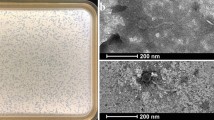Abstract
A novel Ralstonia phage was isolated from soil in Egypt. It was designated Ralstonia phage RsoP1EGY using our phage identifier naming approach to reflect the phage’s bacterial host species, characteristics and origin. When tested, this phage specifically infected only race 3 biovar 2 phylotype IIB sequevar 1, and not non-race 3 biovar 2 strains of Ralstonia solanacearum. The phage has an icosahedral capsid of 60 ± 5 nm in diameter with a short tail of 15 ± 5 nm in length, typical of a podovirus. The genome of RsoP1EGY is 41,297 bp in size, containing 50 open reading frames, with no significant sequence identity to any other reported R. solanacearum or non-Ralstonia phages, except to the recently deposited but unreported and unclassified Ralstonia phage DU_RP_I. RsoP1EGY is the first sequenced and characterized R. solanacearum phage isolated in Egypt.

Similar content being viewed by others
References
Agricultural Bioterrorism Protection Act of 2002 (2002) Possession, use, and transfer of biological agents and toxins; interim rule and request for comments. Fed Regist 240(67):76907–76938
Ahmad AA, Stulberg MJ, Mershon JP et al (2017) Molecular and biological characterization of ϕRs551, a filamentous bacteriophage isolated from a race 3 biovar 2 strain of Ralstonia solanacearum. PLoS One 12:e0185034. https://doi.org/10.1371/journal.pone.0185034
Yamada T (2012) Bacteriophages of Ralstonia solanacearum: their diversity and utilization as biocontrol agents in agriculture. In: Kurtboke I (ed) Bacteriophages. InTech, London, pp 113–138. https://doi.org/10.5772/33983
Bhunchoth A, Phironrit N, Leksomboon C et al (2015) Isolation of Ralstonia solanacearum-infecting bacteriophages from tomato fields in Chiang Mai, Thailand, and their experimental use as biocontrol agents. J Appl Microbiol 118:1023–1033
Murugaiyan S, Bae JY, Wu J et al (2011) Characterization of filamentous bacteriophage PE226 infecting Ralstonia solanacearum strains. Appl Microbiol 110:296–303
Ahmad AA, Askora A, Kawasaki T et al (2014) The filamentous phage XacF1 causes loss of virulence in Xanthomonas axonopodis pv. citri, the causative agent of citrus canker disease. Front Microbiol 5:321. https://doi.org/10.3389/fmicb.2014.00321
Adriaenssens EM, Brister JR (2017) How to name and classify your phage: an informal guide. Viruses 9:70. https://doi.org/10.3390/v9040070
Kropinski AM, Prangishvili D, Lavigne R (2009) Position paper: the creation of a rational scheme for the nomenclature of viruses of bacteria and archaea. Environ Microbiol 11:2775–2777. https://doi.org/10.1111/j.1462-2920.2009.01970.x
Sambrook J, Russell DW (2001) Extraction of bacteriophage λ DNA from large-scale cultures using proteinase K and SDS. In: Sambrook J, Russell DW (eds) Molecular cloning: a laboratory manual, 3rd edn. Cold Spring Harbor Laboratory Press, New York, pp 2.56–2.58
Besemer J (2001) GeneMarkS: a self-training method for prediction of gene starts in microbial genomes. Implications for finding sequence motifs in regulatory regions. Nucleic Acids Res 29:2607–2618
Altschul SF, Madden TL, Schaffer AA et al (1997) Gapped BLAST and PSI-BLAST: a new generation of protein database search programs. Nucleic Acids Res 25:3389–3402
UniProt Consortium (2007) The universal protein resource (UniProt). Nucleic Acids Res 35:D193–D197
Wheeler DL, Barrett T, Benson DA et al (2007) Database resources of the national center for biotechnology information. Nucleic Acids Res 35:D5–D12
Dunn JJ, Studier FW (1983) Complete nucleotide sequence of bacteriophage T7 DNA and the locations of T7 genetic elements. J Mol Biol 166:477–535
Tomlinson DL, Elphinstone JG, Soliman MY et al (2009) Recovery of Ralstonia solanacearum from canal water in traditional potato-growing areas of Egypt but not from designated Pest-Free Areas. Eur J Plant Pathol 125:589–601
Author information
Authors and Affiliations
Corresponding author
Ethics declarations
Conflict of interest
All authors declare that they have no conflict of interest.
Ethical approval
This article does not contain any studies with human participants or animals performed by any of the authors.
Additional information
Handling Editor: Johannes Wittmann.
Electronic supplementary material
Below is the link to the electronic supplementary material.
Rights and permissions
About this article
Cite this article
Ahmad, A.A., Elhalag, K.M., Addy, H.S. et al. Sequencing, genome analysis and host range of a novel Ralstonia phage, RsoP1EGY, isolated in Egypt. Arch Virol 163, 2271–2274 (2018). https://doi.org/10.1007/s00705-018-3844-4
Received:
Accepted:
Published:
Issue Date:
DOI: https://doi.org/10.1007/s00705-018-3844-4




